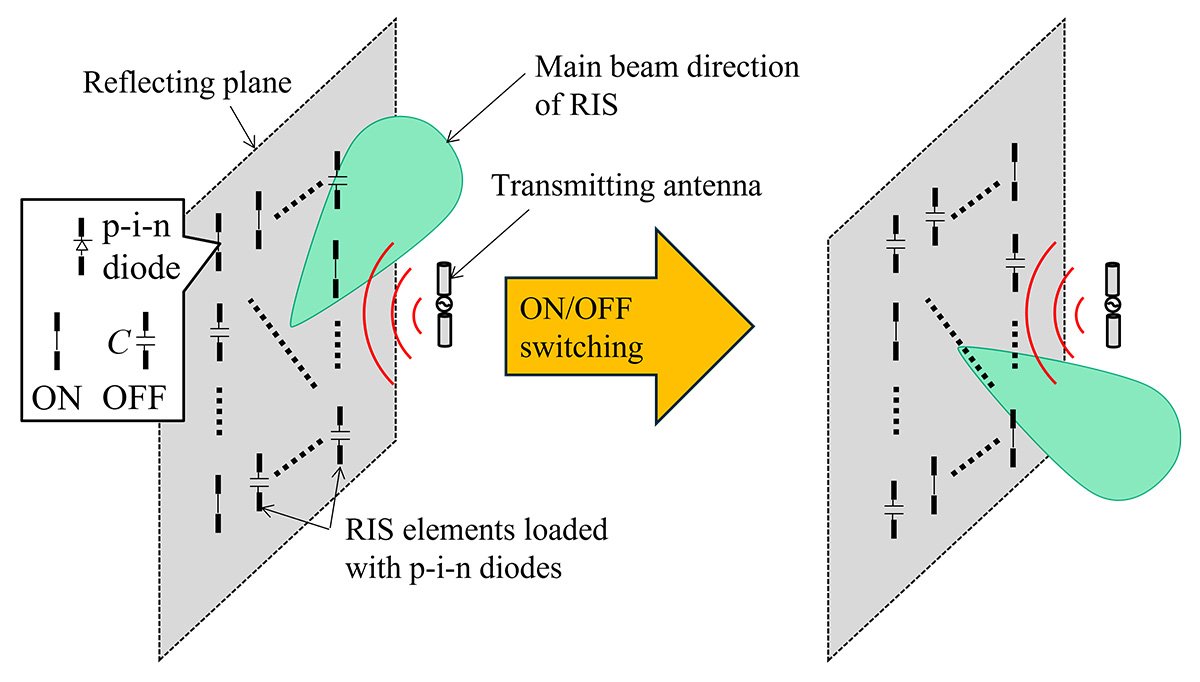A method to analytically express the performance of wireless communication systems when using reconfigurable intelligent surfaces (RIS) was successfully developed by researchers at Tohoku University, the University of Surrey, and the University of Nottingham.
Think of RIS like mirrors. They are thin surfaces that can redirect the propagation direction of radio waves. Instead of bouncing around randomly, radio waves can be purposefully directed in a way that improves the reliability, strength, and range of a signal. For example, the low diffraction rate of high-frequency electromagnetic waves could be optimally adjusted through the use of RIS.
Since RIS are essentially reflective surfaces that can be placed almost anywhere, they are an attractive, less expensive solution than installing entirely new base stations. Modelling the ability of RIS accurately is a crucial initial step before moving towards widescale implementation to improve radio wave signals (such as cellphone service or wi-fi).

"RIS are a promising technology, but we have to research them thoroughly before they can be used practically," explains Keisuke Konno, "As of now, complex, time-consuming, and high-cost measurements or simulations are necessary for evaluating the effect of RIS on improving radio wave propagation."
That's where the model developed by Konno and his team comes in. Various factors predicted by their model almost perfectly matched those obtained by conventional numerical simulations. According to the derived expressions, the effect of RIS on improving the radio wave propagation environment can be evaluated without resorting to other intense and costly simulations.

To create the model, the research team focused on the fact that the mutual coupling between arbitrary shaped transmitting antennas, receiving antennas, and RIS in a wireless communication system could be expressed in the form of an impedance matrix using the method of moments. Firstly, they decomposed the impedance matrix into block matrices (corresponding to the transmitting antenna, receiving antenna, and RIS). Next, by sequentially solving the matrix equations corresponding to those block matrices, they analytically derived an exact expression for the channel capacity (one of the performance indicators of wireless communication systems).
Using these expressions, the performance of wireless communication systems in the presence of RIS can easily be found. This model may serve as a useful guide for determining the best ways to position RIS so we can receive stronger wireless signals - no matter where we are.
These findings were published in IEEE Transactions on Antennas and Propagation on June 27, 2024.
- Publication Details:
Title: Generalised Impedance Model of Wireless Links Assisted by Reconfigurable Intelligent Surfaces
Authors: Keisuke Konno, Sergio Terranova, Qiang Chen, and Gabriele Gradoni
Journal: IEEE Transactions on Antennas and Propagation
DOI: 10.1109/TAP.2024.3417629
Contact:
Keisuke Konno
Department of Communications Engineering, Graduate School of Engineering
Email: keisuke.konno.b5 tohoku.ac.jp
tohoku.ac.jp
Website: http://www.chenq.ecei.tohoku.ac.jp/


